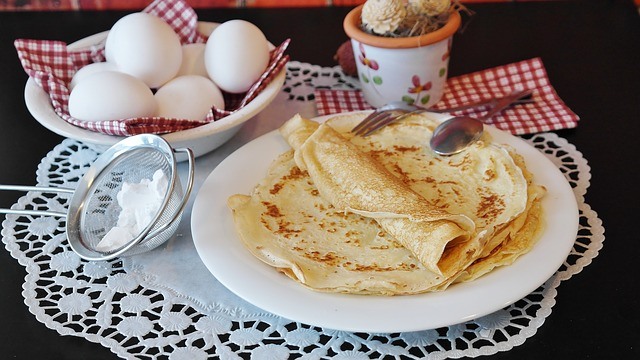If you’re looking to understand the history of the French Crepe, and learn how to make this delicious treat yourself, then you’ve come to the right place.
Here we’ll cover all you need to know about one of the tastiest breakfast foods around, while also showing you the best recipes and unique versions of the pastry, so you can make it yourself!
First things first…
Contents
What is a Crepe?
A crepe is a very thin French pastry, typically served for breakfast or as a dessert.
It is similar to the American version of a pancake, but you instead fold the crepe over any sweet or savory filling, rather than sprinkling ingredients straight into the mix.
It is a pastry that is typically made from buckwheat flour, which became prominent in northern France around the twelfth century in the Bretagne region, also known as the Brittany region to English-speakers.
Not much had grown in Brittany until that point, so the influx of buckwheat became quite the gamechanger.
After grinding the buckwheat crop down and adding water, a touch of salt, and a dab of butter together in a pan, the first crepes were made.
Crepes in this small region were traditionally served with apple cider and eaten with whatever fresh ingredients they had.
The most traditional sweet variation of crepe was made with lemon and sugar, while the most common savory variation was a combination of ham, cheese, and eggs. Today, many different variations of crepes are served and enjoyed all around the world.
One of the most famous variations, the Crepe Suzette, was created in 1895 when a Welsh prince ordered a crepe from the Café de Paris in Monaco.
The chef, Henri Charpentier, threw some orange brandy onto it, lit it on fire in a random spur of inspiration, and served it to the prince. Since then, Crepe Suzette has always been made this way.
Paris still boasts some of the best crepes and creperies on almost every corner that specialize in making all types of crepes.
France has even a holiday dedicated solely to crepes. The second of February is known as the Day of the Crepes, where families celebrate the decline of winter and the coming of spring by eating a meal of crepes together.
There is even a small superstition that is practiced on this day. It is said that if you hold a coin in your preferred writing hand, and the pan with the cooking crepe in the other, if it lands flat after you flip it, then that means your family will be prosperous that year.
A Note on Pronunciation
Though many Americans will pronounce “crepe” as “crape” as if it rhymes with “ape,” this is actually wrong, and the French are especially aggravated by this.
When you say “crepe”, you should emphasize the first e, to make the word rhyme with “step” rather than “ape”.
Even when talking about crepe in the plural sense “crepes”, the French still treat the s as silent, so it would still be pronounced as “crepe”.
How to Make Crepes
Crepes are actually fairly simple to make. In fact, most of the ingredients for them can already be found in your kitchen!
You do not need a fancy crepe maker or special crepe pan to make these. Just use a good non-stick pan with a heavy bottom to allow for even heat and no sticking. Then simply fill with whatever ingredients you want!
Ingredients
- 1 1/2 cups of milk.
- 1 cup of all-purpose flour.
- 2 teaspoons of granulated sugar.
- 1/4 teaspoon of salt.
- 3 tablespoons of melted butter.
- 1/2 teaspoons of vanilla extract.
- 3 large eggs.
- Butter to coat your pan.
- Powdered confectioners’ sugar (optional).
- Desired fillings (optional).
Crepe Recipe
This recipe takes about 25 minutes to make, with 10 minutes for the prep work and 15 minutes for the overall cooking stage. This will make 13 crepes.
- Add your milk, flour, sugar, salt, butter, vanilla extract, and eggs into a blender, then blend on the lowest speed until mixed. This process should take about ten seconds.
- If any flour is stuck on the sides or bottom, scrape at it, then blend for a few seconds longer. This blending process ensures thorough mixing and prevents any lumps from forming in your batter.
- Cover this batter and let it chill for one hour. You can also let it chill overnight, if you prefer. This will help the gluten to develop, which will give you soft and tender crepes.
- Pre-heat a 10-inch non-stick skillet over medium heat. Crepes tend to be very delicate considering how thin they are, so this is to make sure you do not burn them.
- Gently stir the batter with a spoon to blend the separate layers.
- Lightly butter your skillet until it is well-coated, then lift your pan and pour 1/4 cup of your batter in. You will want to immediately tilt and swirl the pan in a circular motion to evenly coat the entire bottom of the pan with batter.
- Cook until golden brown or brown on the bottom, and then use a spatula to lift an edge of the crepe. Carefully grab the edge with your fingertips and flip the crepe over to the opposite side. Cook until golden brown spots appear on the bottom of that side as well.
- Transfer your finished crepes to a wire rack. To keep the crepes warm while you cook the rest of the batter, cover them with a clean kitchen towel. Repeat this process until all of the batter has been used up.
- Dust your crepes with powdered sugar and roll or fold into fourths for a plain variation, or you can fill it with any desired ingredients before you fold it up.
- Enjoy!
Filling Ideas for Your Crepes
Sweet Crepe Ideas
Nutella is a popular filling choice, and can be combined with any fruits you may want as well. Nutella and diced strawberries, or Nutella and banana slices, tend to be popular filling choices for sweet crepes.
Of course, fruit on their own can be a fine enough filling. Typically, fruits like diced strawberries or banana slices drenched in chocolate or caramel syrup are popular choices.
You can also have diced or sliced fruits with sweetened whipped cream, too. Peaches, strawberries, blueberries, and raspberries tend to work well with this special whipped cream.
Cannoli filling, sweetened cream cheese, mascarpone compote, or berry fruit compote are excellent alternatives to the above choices. You can even swap the sweetened whipped cream above for any of these options in your fruit-filled crepes.
Lemon curd or any flavored yogurt will also make a unique crepe filling that you may enjoy. Chocolate sauce, caramel sauce, or even maple syrup works as a simple enhancement to otherwise plain, unstuffed crepes.
Popular sweet variations of crepes in France use salted caramel sauce, melted dark chocolate, and even poached pears. Of course, these are the types of crepes found in fancy restaurants that specialize in these desserts.

Savory Crepe Ideas
While sweet crepes are typically more popular than savory ones, that does not make these crepes any less delicious! In fact, there are even more variations of these types of crepes than their sweeter cousins!
If you want a more savory crepe, however, be sure you do not add any sugar or vanilla to your batter, as these will make your crepe base sweet and clash with the more savory ingredients.
A popular savory crepe choice is to fill it with either a combination of ham and eggs or bacon and eggs. Of course, adding cheese to these variations will also be a tasty alternative.
You may also choose to smother the entire confection in hollandaise for an extra kick in the morning.
For a much fancier filling, you can use a combination of different kinds of meats and vegetables. Slices of steak combined with vegetables like broccoli or kale will make a hearty meal for anyone.
Chicken combined with cream cheese or mushrooms are also very delicious. You can even use taco meat to create a unique cultural fusion of flavor.
Of course, you can also choose to stuff your crepes with seafood as well. Shrimp crepes or crab-filled crepes may suit your fancy, or, if you’re feeling it, smoked salmon may be a good, hearty alternative.
You can even combine meats with fish and vegetables, if you so desire. Shrimp, pork, and any green vegetables tend to work best in combination with one another.
Of course, there are vegetarian-friendly options too!
You can combine any number of vegetables and cheeses together to create a blend of flavors that suits your tastes!
You can combine tomatoes, goat cheese, and basil to create a simple savory crepe, or even combine spinach, artichoke, and brie for a fancier option. Mushrooms and any sort of cheese tend to be very delicious options as well.
Popular savory combinations in France include using goat’s cheese, swiss-style Emmental, mushrooms, and even a savory combination of stewed vegetables like the famous French dish (and Pixar movie) Ratatouille.
Here’s a video showing how to make French crepes.
Conclusion
Crepes are a delicious, thin pastry that is so versatile that they can almost be classified as a sort of culinary phenomenon in their own right.
The best thing about them is that they are very simple to make and customize, too. Whether you choose to fill it with sweet or savory ingredients, it is hard to deny the appeal of either type of French crepe!
From plain and lightly dusted with sugar to stuffed to the brim with ingredients, crepes can be enjoyed however you choose!
If you ever find yourself in France, be sure to visit one of the many creperie stands all around to sample how the locals make their crepes.
If you have the time, you should also head up to the region of Bretagne (or Brittany), the birthplace of the crepe, and sample their versions as well.
Until then, you can use this recipe to make your own at home!
Have you tried making French crepes?






